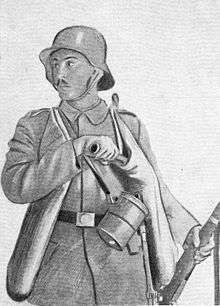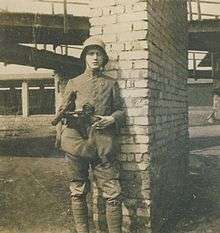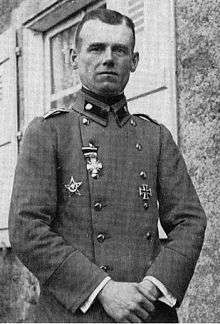Stormtrooper
Stormtroopers were specialist soldiers of the German Army in World War I. In the last years of the war, Stoßtruppen ("Shock troops" or "Thrust Troops") were trained to fight with "infiltration tactics", part of the Germans' new method of attack on enemy trenches.[1] Men trained in these methods were known in Germany as Sturmmann (literally "storm man" but usually translated as "stormtrooper"), formed into companies of Sturmtruppen ("assault troops", more often and less exactly "storm troops"). The infiltration tactics of the stormtroopers are still in use today, in one form or another. Other armies have also used the term "assault troops", "shock troops" or fireteams for specialist soldiers who perform the infiltration tasks of stormtroopers.
History
Prior to World War I
Ever since introduction of breech-loading infantry rifles there had been a growing realization that the days of close order infantry assault were coming to an end. For a time up to the turn of the 19th century armies tried to circumvent the problem by moving into range in dispersed formations and charging only the last metres like the French did in the 2nd Italian war of independence, the Austrians in the War of 1866 against Prussia or the Germans against the French in the Franco-German war of 1870-71. The advent of the machine gun and the adaption of hydraulic-recoil artillery was a further setback for close order and the showing of the Boers in their war against the British fanned an enthusiasm for 'Boer tactics', e.g. open order tactics reliant more on achieving fire superiority and moving when enemy fire was ineffective than positioning oneself for the final bayonet charge.
World War I assault tactics
In the first part of the war, the standard assault on a trench line consisted of a lengthy artillery barrage all along the line, attempting to smash the enemy positions, followed by a rush forward of infantry in massed lines to overwhelm any remaining defenders. This process either failed, or at most gained only a short distance, while incurring enormous casualties, and the armies settled into trench warfare.
Development of tactics
The first experimental Pioneer assault unit of the German army formed in the spring of 1915, founded by Major Calsow and later commanded and refined by Hauptmann Willy Rohr. The methods which Rohr developed form the basis of all modern small-unit infantry tactics.[2]
Infiltration tactics in the Allied armies were first formally proposed by French Army captain André Laffargue.[3] In 1915 Laffargue published a pamphlet, "The attack in trench warfare", based upon his experiences in combat that same year. He advocated that the first wave of an attack identify hard-to-defeat defenses but not attack them; subsequent waves would do this. The French published his pamphlet "for information", but did not implement it. The British Empire armies did not translate the pamphlet, and the British Army continued to emphasise fire power, although Laffargue's proposals were gradually adopted informally, first by the Canadian Corps.
The Germans captured copies of Laffargue's pamphlet in 1916, translating and issuing it to units,[4] but by this point they already had their own, more sophisticated infiltration tactics, over two months before Laffargue's pamphlet was published.[5][6][7][8] Soldiers were trained to consider fire as a means to facilitate movement in progress. Movement would be a call for fire. N. R. McMahon advocated using combined arms in the attack, particularly light machine guns (some six light and two heavy MGs per battalion) using a decentralised fire control and tactical command system (known as Auftragstaktik in German). These methods, suggested in 1909, bore a strong resemblance to the Stoßtrupptaktik used by the Germans six years later.[9]
In February 1917, the British Army issued Manual SS 143 on the subject. Using them throughout 1917, the British perfected all-arms battle. The British made the platoon the basic tactical unit rather than the company as in 1916. The platoon was made up of four sections, Lewis Gun, rifle grenade, grenade and rifle. The new organisation allowed the platoon to make best use of the trench-fighting equipment that had arrived in adequate quantities since the beginning of the battle of the Somme. They were also supported by sophisticated artillery flash-spotting and sound-ranging, something the German Army never perfected, instead relying on the aural method with ever more accurate measuring devices.[10]
German Storm troopers
Calsow Assault Detachment
The concept of "Stormtroopers" first appeared in March 1915, when the Ministry of War directed the Eighth Army to form Sturmabteilung Calsow ("Calsow's Assault Detachment" or SA Calsow). SA Calsow consisted of a headquarters, two pioneer companies and a 37mm gun (Sturmkanone) battery. The unit was to use heavy shields and body armor as protection in attacks.
However, SA Calsow was never employed in its intended role. Instead it was sent into the line in France as emergency reinforcements during heavy Allied attacks. By June, the unit had already lost half its men. Major Calsow was relieved for this, against his protests that it was not his fault that the unit was not used as intended.[1]
Rohr Assault Battalion


The new commander of the Assault Detachment from 8 September 1915 was Hauptmann (Captain) Willy Rohr, previously commander of the Guard Rifle Battalion. The Assault Detachment was reinforced with a machine gun platoon and flamethrower platoon. The old infantry support guns had been shown to be too difficult to move across the battlefield, and a new model was developed based on captured Russian 76.2mm fortress guns and issued to the Assault Detachment.[1][11][12]
Captain Rohr (later promoted to Major[1]), at first experimented with the Assault Detachment's body armor and shields, but realized that speed was better protection than armor. The only item of armor kept was the Stahlhelm, a new model of steel helmet. It later became the standard in all German units by the end of the war, and was used throughout World War II.[1]
The new tactics developed by Captain Rohr, building much on his own previous experiences from the front, was based on the use of squad sized stormtroops ("Sturmtruppen" or "Stoßtruppen"), supported by a number of heavy support weapons and field artillery that was to be coordinated at the lowest level possible and rolling up enemy trenches using troops armed with hand grenades. These tactics were tested the first time in October 1915 in a successful assault on a French position in the Vosges Mountains.[1]
In December 1915, the Assault Detachment started training men of other German units in the new assault tactics. Around this time the Assault Detachment also changed some of its equipment to better fit its new requirements. Lighter footwear was issued, and uniforms were reinforced with leather patches on knees and elbows to protect them when crawling. Special bags designed to carry grenades replaced the old belts and ammunition pouches, and the standard Gewehr 98 rifle was replaced with the lighter Karabiner 98a previously used by cavalrymen. The long and impractical épée-style Seitengewehr 98 bayonet was replaced by shorter models, and supplemented with trench knives, clubs, and other melee weapons. While continuing to train other units, the Assault Detachment also participated in many small trench raids and attacks with limited objectives.[1]
The first major offensive led by the new Assault Detachment was the initial German attack at Verdun in February 1916. Stormtroops were in the first wave, leading some units into the French trenches, attacking seconds after the barrage had lifted. This generally worked very well, even though it worked much better against the first trenchline than against the less well-known enemy rear-area.[1]
On 1 April 1916, the Assault Detachment was redesignated "Assault Battalion Rohr". Around this time it was expanded from two to four pioneer companies. At the same time, several Jäger battalions began retraining as new Assault Battalions.[1][13]
Hutier and the last German offensive
General Oskar von Hutier, now commanding Eighth Army, became a champion of the new tactics, which became known as Hutier tactics in England and the United States. Hutier suggested an alternative approach, combining some previous and some new attacks in a complex strategy[14]
- A short artillery bombardment, employing heavy shells mixed with numerous poison gas projectiles, to neutralize the enemy front lines, and not try to destroy them.
- Under a creeping barrage, Stoßtruppen would then move forward, in dispersed order. They would avoid combat whenever possible, infiltrate the Allied defenses at previously identified weak points, and destroy or capture enemy headquarters and artillery strongpoints.
- Next, infantry battalions with extra light machine guns, mortars and flamethrowers, would attack on narrow fronts against any Allied strongpoints the shock troops missed. Mortars and field guns would be in place to fire as needed to accelerate the breakthrough.
- In the last stage of the assault, regular infantry would mop up any remaining Allied resistance.
The new assault method had men rushing forward in small groups using whatever cover was available and laying down suppressive fire for other groups in the same unit as they moved forward. The new tactics, which were intended to achieve tactical surprise, were to attack the weakest parts of an enemy's line, bypass his strongpoints and to abandon the futile attempt to have a grand and detailed plan of operations controlled from afar. Instead, junior leaders could exercise initiative on the spot. Any enemy strong points which had not been overrun by stormtroopers could be attacked by the second echelon troops following the stormtroopers.
Stormtroopers in 1917
The general activation of Stosstruppen style assault troops across the whole Ottoman Army was ordered on 1 September 1917, by Enver Pasha, with the XV Corps, the First Army and the Fourth Army (operating in Palestine and Syria) to establish the 1st, 2nd, and 3rd Assault Battalions respectively. In addition, he ordered each infantry division in the Yildirim Army Group and in the Fourth Army to establish assault detachments consisting of the best officers, NCOs, and men from the best units in the division. These soldiers were required to be 27 years or younger, intelligent, healthy and strong and their assault units were given a one-month assault course, better rations, and a badge embroidered with a hand grenade. The divisional assault detachments later matured into assault battalions.[15] Within the Ottoman Army, unlike the German Army, there were no Stosstruppen/assault divisions.[16]
Stormtroopers in 1918
With the withdrawal of Russia, Germany moved troops from the Eastern Front to reinforce the Western Front. This allowed them to take units out of the line for retraining as storm troopers.
On 21 March 1918, Germany launched Operation Michael, a major offensive, using the new tactics. Four successive German offensives followed and for the first time in four years the stalemate of trench warfare was broken. However, the German advance failed to achieve the complete breakthrough necessary for a decisive result and in July the Allies began their Hundred Days Offensive.[10]
Reasons for the failure of the offensive
Apart from suffering heavy casualties several other reasons for the failure of the Stormtroops have been suggested.
- The initial attack was against the British section of the front which was the most strongly held.[17]
- The leading units were not relieved or rotated out of action and became exhausted.[1]
- The terrain contained many rivers, towns, forests and canals which slowed the advance.[1]
- The 1918 influenza epidemic.[18]
- The capture of British stores which contained large quantities of alcohol - "not for lack of German fighting spirit, but on account of the abundance of English drinking spirit!"[19]
3rd and 46th Assault Company
With three infantry battalions, the German 703rd Infantry Battalion, some machine-gun, cavalry and artillery units, the 3rd Assault Company and the 46th Assault Company counterattacked the Egyptian Expeditionary Force during the Sinai and Palestine Campaign. At the First Battle of Amman fought during the First Transjordan attack on Amman at the end of March 1918, the attackers were forced back to the Jordan River.[20]
23rd Assault Detachment
The assault troops were organised into combined arms assault detachments ... The assault detachment of the 23rd Infantry Division was composed of one infantry company (about 100 men), one engineer (pioneer) platoon (one officer, four NCOs and thirty men), and seven light machine–gun teams. The officers assigned to the assault detachments were hand–picked from within the division by the division staff. The assault detachment was given a four–week course in German–style stormtrooper tactics, to which the division sent an additional officer and five NCOs. Eventually the assault detachment was expanded into an assault battalion, giving the 23rd Infantry Division additional combat capability.[21]
24th Assault Company
With the 3rd Battalion 145th Infantry Regiment (24th Infantry Division) and the 8th and 9th Cavalry Regiments (3rd Cavalry Division), the 24th Assault Company (24th Infantry Division) pushed the Egyptian Expeditionary Force back from Es Salt at the end of April 1918 during the Second Transjordan attack on Shunet Nimrin and Es Salt.[20]
46th Assault Company
This assault company remained in reserve at Amman during the attack on Es Salt.[20]
Effect on the Weimar Republic
According to Vanguard of Nazism by Robert G. L. Waite and Male Fantasies of Klaus Theweleit, some of the psychological and social aspects of the Stormtrooper experience found their way into the Weimar republic paramilitary groups such as the Freikorps, which were largely made up of World War I veterans. For example, the formal barrier between officer and staff was largely broken down and replaced by a fierce loyalty. There was also a 'brutalization' process owing to the uniquely violent conditions of such raids.
Austro-Hungarian Assault Units
During the winter of 1914–1915 large parts of the Eastern Front switched to trench warfare. To cope with the new situation many Austro-Hungarian regiments spontaneously formed infantry squads called Jagdkommandos. These squads were named after the specially trained forces of Russian army formed in 1886 and were used to protect against ambushes, to perform reconnaissance and for low intensity fights in no-man's-land.
Austro-Hungarian High army command (Armeeoberkommando, AOK) realised the need for special forces and decided to draw on German experience. Starting in September–October 1916 about 120 officers and 300 NCOs were trained in the German training area in Beuville (near the village of Doncourt) to be the main cadre of the newly raised Austro-Hungarian army assault battalions. The former Jagdkommandos were incorporated into these battalions.
Ottoman Stormtroopers
During the Middle Eastern theatre of World War I, especially in Sinai and Palestine Campaign, Ottomans utilized Yıldırım Army Group which used the latest Western Front infiltration tactics and close combat gear such as Stahlhelms and stick-grenades with concentrated fire of artillery and machine guns.[22][23]
See also
References
Footnotes
- 1 2 3 4 5 6 7 8 9 10 11 Gudmundsson, Bruce I. (1995). Stormtroop Tactics: Innovation in the German Army, 1914-1918. Praeger Paperback. pp. 46–78. ISBN 0-275-95401-3.
- ↑ Lt. Col. Thomas Kratman, U.S. Army, ret., personal communication
- ↑ CSI Report No. 13: Tactical responses to concentrated artillery: Introduction (Combat Studies Institute, U.S. Army Command and General Staff College, Fort Leavenworth).
- ↑ CSI Report No. 13: Tactical responses to concentrated artillery: Ch 2 (Combat Studies Institute, U.S. Army Command and General Staff College, Fort Leavenworth).
- ↑ Samuels, Martin Doctrine and Dogma, passim
- ↑ Samuels, Martin Command or Control?, passim
- ↑ Stormtroop Tactics, Appendix C and passim
- ↑ Samuels, Martin Doctrine and Dogma, 55
- ↑ Samuels, Martin (1995). Command or Control? Command, Training and Tactics in the British and German Armies, 1888–1918. London: Frank Cass. pp. 100–101. ISBN 0-7146-4214-2.
- 1 2 Griffith, Paddy (1994). Battle Tactics of the Western Front: The British Army's Art of Attack, 1916–18. New Haven, Conn: Yale University Press. pp. 194–195. ISBN 0-300-05910-8.
- ↑ Jäger, Herbert (2001). German Artillery of World War One. Crowood Press (UK). p. 136. ISBN 1-86126-403-8.
- ↑ Samuels, Martin (1995). Command or control? Command, training and tactics in the British and German armies 1888-1918. London: Frank Cass. p. 89. ISBN 0-7146-4214-2.
- ↑ Rogers, Duncan F.; Cron, Hermann (2002). Imperial German Army 1914-18: Organisation, Structure, Orders of Battle. Helion & Company. p. 119. ISBN 1-874622-70-1.
- ↑ Westwell ,I., World War I Day by Day By Ian Westwell
- ↑ Erickson 2007 p. 104
- ↑ Erickson 2007 p. 105
- ↑ Delany, J., The Blitzkrieg campaigns: Germany's "lightning war" strategy in action
- ↑ The Myth of the Great War: A New Military History of World War I,John Mosier - 2002
- ↑ Soldiers: a history of men in battle - John Keegan, Richard Holmes, John Gau - 1986 - 288 pages
- 1 2 3 Erickson 2007 p. 134
- ↑ Erickson 2007 p. 133
- ↑ https://books.google.com.tr/books?id=dsSQCgAAQBAJ&pg=PR63&lpg=PR63&dq=ottoman+stormtroopers&source=bl&ots=a7atupuUhB&sig=-8XY7cKGe157ow2c8Nff_V9hU_o&hl=tr&sa=X&ved=0ahUKEwiGttnaq73QAhUHuhoKHeluB_wQ6AEISDAI#v=onepage&q=ottoman%20stormtroopers&f=false
- ↑ https://books.google.com.tr/books?id=y64ODAAAQBAJ&pg=PT482&lpg=PT482&dq=ottoman+stormtroopers&source=bl&ots=TT7ZYvsSBS&sig=wDjFXW64Cjwa9dnhyOfCgzcEEns&hl=tr&sa=X&ved=0ahUKEwiGttnaq73QAhUHuhoKHeluB_wQ6AEITTAJ#v=onepage&q=ottoman%20stormtroopers&f=false
Bibliography
- Cron, Hermann; Rogers, Duncan F. (2002). Imperial German Army 1914–18: Organisation, Structure, Orders of Battle. Helion. ISBN 1-874622-70-1.
- Erickson, Edward J. (2007). Gooch, John; Holden Reid, Brian, eds. Ottoman Army Effectiveness in World War I: A Comparative Study. Cass: Military History and Policy. Abingdon: Routledge. ISBN 978-0-203-96456-9.
- Griffith, Paddy (1994). Battle tactics of the Western Front: The British Army's Art of attack, 1916–18. New Haven, CN: Yale University Press. ISBN 0-300-05910-8.
- Jäger, Herbert (2001). German Artillery of World War One. Marlborough: Crowood Press. ISBN 1-86126-403-8.
- Samuels, Martin (1995). Command or Control? Command, Training and Tactics in the British and German armies 1888–1918. London: Frank Cass. ISBN 0-7146-4214-2.
- Ortner, Christian (2006). Storm Troops: Austro-Hungarian Assault Units and Commandos in the First World War. Vienna: Militaria Verlag. ISBN 978-3-9501642-8-2.
External links
- The Dynamics of Doctrine: The Change in German Tactical Doctrine During the First World War
- Jones, Simon. Infiltration by Close Order: André Laffargue and the Attack of 9 May 1915.
